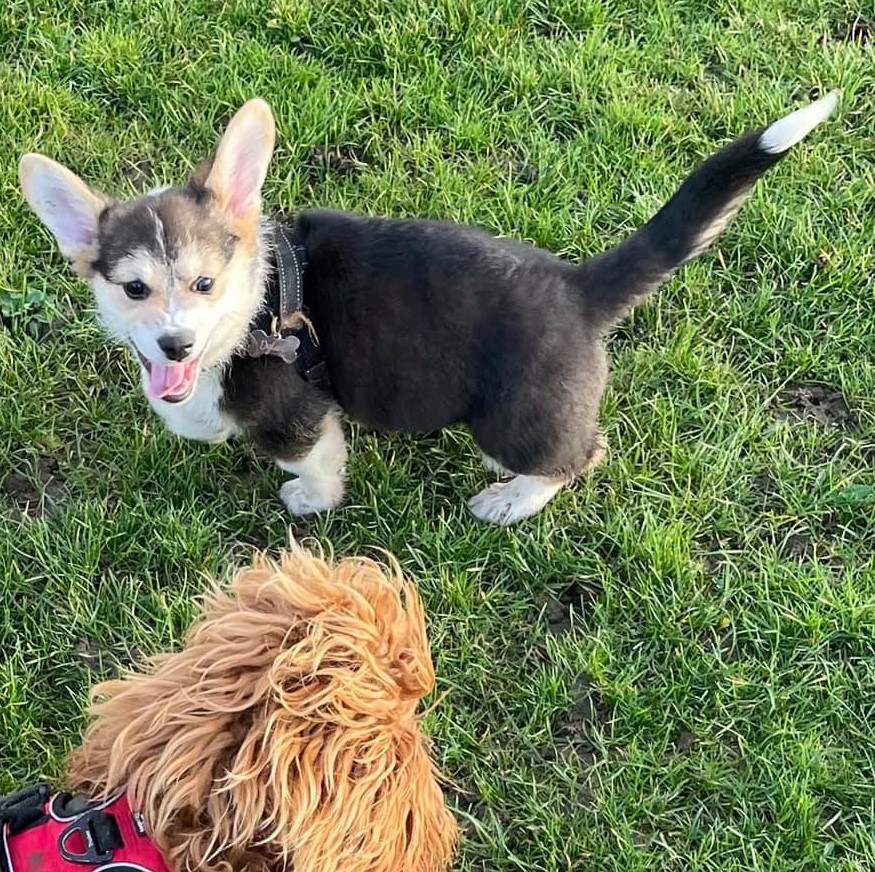The importance of stress levels and working under threshold, by Jo Maisey
There is never any substitute for getting in a qualified and experienced behaviourist, who will be able to see what the cause of the problem is, give you advice on managing the problem, then look at fixing the problem.
The following advice will do no harm and put you on the right road until you can see a behaviourist. In this instance I am using the example of the dog concerned being reactive to other dogs, but the same principles can apply to other situations a dog may react to.
What is a Reactive Dog?

A reactive dog is one that will bark, growl, lunge, snap, etc at certain things (stimuli), eg dogs, people, traffic. It can be very stressful living with a reactive dog, not to mention embarrassing for the person on the other end of the lead!
Socialising
The time for socialising dogs – ie getting them used to anything and everything so that they are comfortable with what life throws at them is when they are puppies – up to around 16 weeks of age. After that, you’re into a programme of counterconditioning (turning around their underlying emotional response) and de-sensitising. Merely exposing them to things they find scary is very unlikely to change their underlying emotional response and is likely to make them more reactive.

Settling into a New Home
When any dog, no matter how well adjusted, goes to a new home, she is bound to find things a little scary. Everything is new. She doesn’t know her way around. She doesn’t know what is expected of her. She doesn’t know the people in the new house or whether she can trust them. In the early days, I tend to keep things low key and their world quite small. That way, she can become used to things slowly and gently without having a whole load of things to deal with all at once.
Stress and therefore adrenalin levels need to be given a chance to come down. I would avoid anything that a dog finds scary/is reactive to initially, otherwise you might find yourself in an ever increasing cycle of reactivity.
Initially, dogs are often worried about things, but not relaxed enough to show how they feel. After they have relaxed, they then feel able to tell you they are not comfortable about some situations – perhaps other dogs or certain people being near them.
Fear and Reactivity
Reactive dogs are usually fearful. Truly confident dogs do not need to give a big show; they can make the other dog go away by using some very subtle body language. Fear is reflexive and emotional and not something a dog can help doing. By being reactive, they are making the other dog go away! While on lead, they do not have the option of flight from the fight/flight response, so must resort to fight. This may become a learned behaviour – after all, it’s a strategy that works!
Management and Dealing with the Problem
This is how I would approach it:
- Keep things low key to allow adrenalin/stress levels drop. Stressed dogs cannot learn
- Set up to succeed. This means avoiding any areas where you think she may kick off. If you see another dog, turn around, walk the other way, cross the road, body block, hide behind a tree, put her behind your legs. Whatever it takes to avoid the other dog. Don’t put her in a position where she feels the need to defend herself. Apart from allowing her stress levels to drop, this will have the added benefit of her learning to trust you and that you will deal with the scary thing, so she has no need to
- Remember that any time there is an ‘incident’, her stress levels will rise, meaning that she is likely to be more reactive for possibly the next few days. Things that she will ordinarily have been able to cope with, she may not while her stress levels are raised
- Trigger stacking – say the level at which she reacts is a ten. The postman is a four, so she doesn’t react. A kid on a bike is another four, totalling eight, but still below her threshold of ten, so she doesn’t react. Then she sees a car. This is only a two and so there would normally be no reaction at all, but added to the previous eight, it’s tipped her over threshold and so she will react. Trigger stacking explains why dogs, which are normally non-reactive to things, may react to seemingly non-scary things. Imagine this goes on day after day! An ever increasing spiral and the dog ends up reacting to everything!
- Once her adrenalin/stress levels have dropped, you can start to work on her underlying emotional response
- You need to work sub-threshold. This is very important. Stressed dogs cannot learn. The threshold is a distance at which she can see the scary thing, but not react. This is called the critical distance. Sometimes it can be a massive distance! It can also change from day to day and even hour to hour, depending on what’s happened previously, ie where her stress levels are at. It also depends on how scary the other dog is. Direct eye contact is challenging. A direct approach is challenging. Squashed faced dogs and docked dogs are more difficult to read. Dogs with an upright stance and pricked ears are challenging. So, the critical distance is not set in stone. Better to be further away than you think you need to be, than too close and therefore elicit a reaction
- Now we need to look at changing the underlying emotional response. Currently her response to seeing another dog is ‘OH MY GOD!!! IT’S A SCARY THING!!! I NEED TO MAKE IT GO AWAY’. We want to change that to ‘Oh look. Another dog. Goody! Where’s my sausage!’
- The way to do that is to pair the scary thing with something she finds incredibly rewarding. The easiest thing is food. Very yummy food. Food that she never gets at any other time, so kibble won’t cut it! Liver cake? Roast chicken? Whatever it takes. The size of the food needs to be tiny; about pea-sized and you need lots of it! It needs to be tiny as you don’t want to have to wait while she chews it. There needs to be lots of it so that you can continually feed her one bit at a time
- So, once the scary thing (another dog) is in her sight (it’s very important that she is aware of it) and you are sub-threshold, then you start shovelling the yummy food down her throat. It’s very important that she is aware of the dog and then you start to feed her immediately. Once the dog is out of her sight then you stop feeding her. That way, the dog becomes a predictor of yummy stuff. If you feed her before she sees the dog, then the food will become a predictor of scary things!
- You are not asking her for any particular behaviour or to do anything other than she has seen the dog at this point. Remember, fear is an emotional, reflexive response and something she cannot help. You will not be reinforcing it by rewarding her as emotions cannot be reinforced
- If she would normally take treats but won’t, then the likelihood is that you are too close. Stressed dogs won’t eat
- If she reacts, then again you are probably too close and there is no point in trying to do anything. Best to just walk away and try again another day
- If you are not already, it would be best to walk her on a harness, perhaps with a double-ended/training lead clipped to both her harness and collar for safety. If she is reacting/lunging on just a collar, it is likely to cause her pain. She is then likely to associate the pain with the other dog and so this will make her more reactive. Do not use a choke chain or slip lead as these will cause pain. Dogs learn by association
Over time, you should see the critical distance reduce, and her looking to you for yummy stuff when she sees another dog. How long this will take is a bit of a piece of string question!
Summary
- Allow stress levels to drop.
- Apply management techniques to avoid triggers and set up to succeed. You don’t want it to become a learned/ingrained behaviour, so you want to avoid her practising it.
- Follow a programme of systematic desensitisation.
Real life happens. Don’t get disheartened if things go a bit wrong and she reacts. Just try again another time. The mistake most of us make is trying to take things too quickly, not listening to our dogs nor taking it at their pace. We’ve all been there!
